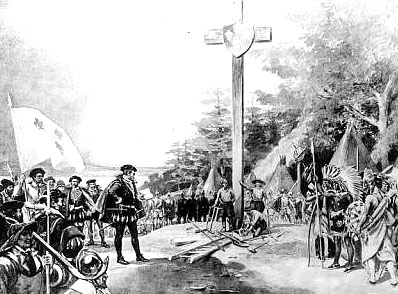 Our country was founded by great saints who established, near the shores of the majestic Saint Lawrence River, a Catholic people, proud of its origins and faith.
Our country was founded by great saints who established, near the shores of the majestic Saint Lawrence River, a Catholic people, proud of its origins and faith.
In France, April 20th, 1534, Jacques Cartier left the port of Saint Malo in France as leader of two ships and 61 people. The conditions of the climate are excellent and he completes his journey in only 20 days.
In 1534, Jacques Cartier, the discoverer of Canada, takes possession of the country by planting a cross in Gaspe.
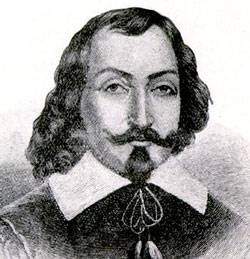 We celebrate in 2008, the fourth centenary of the city of Quebec founded by Samuel of Champlain, whose motto was: "The salvation of a soul is worth more than the conquest of an empire."
We celebrate in 2008, the fourth centenary of the city of Quebec founded by Samuel of Champlain, whose motto was: "The salvation of a soul is worth more than the conquest of an empire."
He had missionaries come to evangelize the native population. His goal was to establish a new Catholic French colony in New France. His apostolic zeal made of him a great collaborator of the missionaries. He was really the Father of New France.
The Recollets, the Jesuits, the secular priests, and other religious communities contributed by enormous sacrifices to the foundation of Quebec, some at the price of their blood. They were great souls who gave themselves totally to God for the conversion of the savages, the education of the children and the care of the sick. This period of the foundation of New France was called "mystical epic." As the great Pope John Paul II said, during his visit in Canada in 1984: "For the place on which you stand is holy ground."
On July 3, 1908, Samuel de Champlain took possession of Quebec City by placing a white flag. Champlain then put all of his men to work. Some felled trees, and others cut them to make boards for construction.
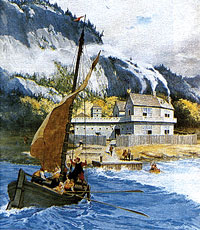 They had to construct a spacious house of two stories that serves as a residence for the governor and as a general store for the colony. They named the house: The Habitation. Then they had their first sowing. Champlain wrote to his friends in France: "The country is beautiful and pleasant. The grain and vegetables ripen easily. The trees and wild fruit are many. There is much fish, the prairies are plentiful and the game is abundant."
They had to construct a spacious house of two stories that serves as a residence for the governor and as a general store for the colony. They named the house: The Habitation. Then they had their first sowing. Champlain wrote to his friends in France: "The country is beautiful and pleasant. The grain and vegetables ripen easily. The trees and wild fruit are many. There is much fish, the prairies are plentiful and the game is abundant."
The founder of Quebec City had as his priority the conversion of the native people. As he repeated often in his letters: "The conversion of an infidel is worth more than the conquest of an empire."
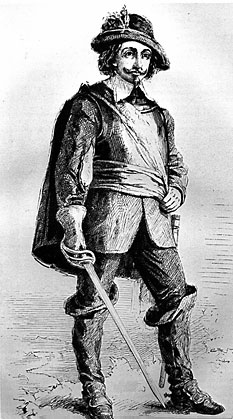 Champlain went to the country of the Hurons to teach them that God was made man to save us; that He came on earth, healed the sick, resurrected the dead and chased away demons. Champlain became important very quickly in the eyes of the Hurons, the Montagnais and the Algonquins who did not start anything without consulting him. They conserved the memory of Champlain even more so than their missionaries, even though they were fond of them.
Champlain went to the country of the Hurons to teach them that God was made man to save us; that He came on earth, healed the sick, resurrected the dead and chased away demons. Champlain became important very quickly in the eyes of the Hurons, the Montagnais and the Algonquins who did not start anything without consulting him. They conserved the memory of Champlain even more so than their missionaries, even though they were fond of them.
Two great enemies slowed this heroic work of the beginning of New France: sickness of scurvy the caused the death of many French people who came to Canada to clear the land and the ferocious Iroquois who destroyed all in their path.
Even with the great losses caused by the enemy, the colony slowly but surely developed, so well that Champlain believed that the moment had come to put into execution the project that he had cherished for so long. His idea was to bring missionaries who would strengthen the Faith of the Whites, and who would preach the Gospel to the American Indians.
Four Recollets accepted to accompany Champlain to New France: they were Fathers Denis Jamay, Jean Dolbeau, Joseph Le Caron and Brother Pacifique Duplessis.
In one month, they built a house with a chapel for them. On June 25, 1615, Father Jean Dolbeau had the honor and the great joy to celebrate his first Mass in Quebec. The inhabitants had prepared themselves for a fervent confession. They went to Holy Communion and sang the Te Deum with the priest.
The Recollets then constructed their first monastery, on the shore of the St. Charles River, two kilometers away from the famous "Habitation" of Champlain. The religious themselves joined in the task for the construction. The new monastery was soon ready to receive not only the religious, but also a certain number of young American Indian students.
The missionaries had visited all of the regions and they realized that in order to develop the colony they would need pioneers. Fathers Jamay and Le Caron accompanied the Governor to France, in order to plead with him for the cause of the colony. Religion did not only offer a moral and spiritual frame to the citizens, it also consisted of a base to their social life. All assisted at Sunday Mass and many social exchanges were held before and after the celebration. The Church was the place where many ceremonies were held during the course of the year. The Church also directed the hospitals and schools and did charitable work. Our three ambassadors came back from France with a contingent of men even more considerable then the previous years. They brought with them more missionaries, and our first Canadian colonists: Louis Hebert, his wife and children...
The first colonist of New France, Louis Hebert, was an apothecary (pharmacist) in Paris. He had already come with Champlain in America in 1604 and had established himself in Acadia, but unfortunately, the pirate Argall had destroyed Port Royal from top to bottom. Hebert then returned to France.
We cannot understand the quality of the souls of our ancestors if we do not try to follow in this first step of the ocean crossing. During that time, you needed a courage surpassing others in order to face a voyage on the ocean. These adventurers of the ocean were audacious, strong during hardship; they had joy, but they were otherwise for the earth, peasants, fathers of families, women and children. For them, the voyage was a real martyrdom.
Those who embarked for New France knew that they were in danger for their lives, so each person went to Confession, Communion, and made their last will and testament before leaving.
In 1617, after many years of preparation, Louis Hebert obtained the permission to go establish himself in Quebec with his wife, Marie Rollet and their three children, Anne, Guillemette and Guillaume. The journey was long and hard. On June 14, as if by miracle, their ship in distress finally arrived in Tadoussac. All of passengers and mariners disembarked to thank God. They constructed a chapel from branches and Father Huet celebrated a Mass in thanksgiving.
A few days later, Louis Hebert and his family went down to Quebec to the great joy of all of the population who hailed him as the first colonist of New France. He took possession of ten acres of land that the King had given him, at the summit of the cliff of Quebec, and there he built a house.
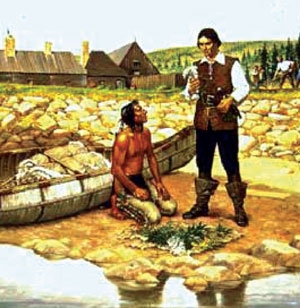 At the same place where we find the bishops residence in Quebec, the Basilica, and the University of Laval; Louis Hebert cut down trees, cultivated the earth, planted vines and apple trees and sowed beans, wheat from India and France. Since he was a pharmacist, he gathered herbs that served to heal sicknesses, especially the terrible scourge of scurvy. The American Indians called him: the gatherer of herbs. All of these energetic activities gave considerable help to the colony. Champlain was admired by all.
At the same place where we find the bishops residence in Quebec, the Basilica, and the University of Laval; Louis Hebert cut down trees, cultivated the earth, planted vines and apple trees and sowed beans, wheat from India and France. Since he was a pharmacist, he gathered herbs that served to heal sicknesses, especially the terrible scourge of scurvy. The American Indians called him: the gatherer of herbs. All of these energetic activities gave considerable help to the colony. Champlain was admired by all.
Death soon came to visit the Hebert family. First his eldest daughter, Anne, who had just married Antoine Jonchet; then Antoine Jonchet himself died. Later Louis Hebert, during the month of January in 1627, had a fatal fall on the ice.
After having piously received the last sacraments of the Church from the hands of Father Le Caron, he said to those standing around his bed: "I die happy because Our Lord gave me the grace to see with my own eyes, Indians who have converted to the faith. I crossed the ocean in order to come to their aid, and now I die for their conversion if that is the good pleasure of God. I ask you to love them as I did and to assist them as much as you can. God will reward you in Paradise. I exhort you to love one another in peace. This life is of short duration, but the one that follows lasts for eternity. I am ready to go towards my God to whom I must render an account of my entire past life. Pray for me so that I will find grace before His Face and that I may someday because counted among his elect."
Raising his hand, Louis Hebert blessed his family who was in tears, and rendered his soul to his Creator on January 25, 1627. It was a great loss for the French, and for the American Indians as well, they sorely missed this "real foster-father."
 The Recollets were in Canada for ten years, but there was not a sufficient amount of them for the quantity of work there was. So they asked the Jesuit Fathers of Paris to send them five religious. Among them that were sent, was Father Jean de Bredeuf and Gabriel Lalemant. They disembarked on the shore in 1625. They stayed for two years in the house of the Recollets, then they acquired their own large residence on the edge of the St. Charles River. They plowed and sowed the land themselves in order to have food.
The Recollets were in Canada for ten years, but there was not a sufficient amount of them for the quantity of work there was. So they asked the Jesuit Fathers of Paris to send them five religious. Among them that were sent, was Father Jean de Bredeuf and Gabriel Lalemant. They disembarked on the shore in 1625. They stayed for two years in the house of the Recollets, then they acquired their own large residence on the edge of the St. Charles River. They plowed and sowed the land themselves in order to have food.
Mrs. Hebert was very much afflicted by the death of her husband, but she had the consolation of having a son-in-law Gullaume Couillard, who married her daughter Guillemette in 1621. He was a pioneer as well. He promised Mrs. Hebert that he would help her to develop the work that had been so well started. The famous couple, Guillaume and Guillemette, gave 10 children to the country and a great number of descendants.
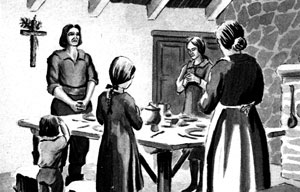 In spite of all their courageous efforts, famine came once again to the colony. The English came to force Champlain to give to them the locale where the colony was situated, in 1628. After resisting as much as they could, Champlain saw the obligation to capitulate in 1629. He returned to France with the religious.
In spite of all their courageous efforts, famine came once again to the colony. The English came to force Champlain to give to them the locale where the colony was situated, in 1628. After resisting as much as they could, Champlain saw the obligation to capitulate in 1629. He returned to France with the religious.
But Mrs. Hebert and Guillaume Couillard were determined to live on the acres of land that Louis Hebert had cultivated. They stayed in Quebec. They had promised Champlain to watch over the two little American Indians that they had adopted, who they called Hope and Charity. For three years, Mrs. Hebert and Guillaume Couillard courageously stayed on the land in the midst of the English.
In the meantime, there was a truce between France and England and New France was given back to France in 1632, by the treaty St. Germain-en Laye.
After the departure of the Kirkes, Champlain had returned to Canada in 1633 with the three vessels: The St. Peter, The St. John and the Gift of God, carrying two hundred people, merchandise, arms, provisions, and a grand title: "Lieutenant-general of all the appointed of the St. Lawrence River." Faithful to his promise, they had started to build a modest chapel that they dedicated with much love and in recognition to Mary, Our Lady of Recovery, to thank her for giving us Canada through France. When our first colonists, after having suffered so much from the enemy, saw the white flags on the ships of the French, tears of joy flowed down their faces and the valiant colonists rested at their post. What an inexpressible happiness it was as well to see the Holy Mass celebrated in their home after being deprived of it for three years!
Marie Rollet-Hebert opens in her house the first boarding school for the little American Indians. She often accepted to be the god-mother of the Indians who were baptized. She died on 1649 after having served the Canadian country for thirty-two years. Her name shines in the first pages of our beautiful history of Canada.
 Guillaume Couillard Guillaume Couillard |
Then the King of France honored Guillaume Couillard with the title and privileges of a Lord. In 1637, his oldest daughter, Louise Couillard married Olivier Le Tardif. He was an interpreter of the languages of the savages (1623); General of the Company of the Hundred Associations (1641); he was a precious help to the Jesuit Fathers in their work of evangelization; co-Lord and procurator general of all of the Lords in Beaupre.
The second daughter of Guillaume Couillard, Marguerite married Jean Nicolet, the discoverer of Michigan.
Guillaume Couillard was then one of ground-breakers to establish the Church in Quebec, there since the Basilica of the archdiocese. He died in 1663 and was exhumed in the chapel of the Hotel-Dieu. His home served as the beginning of the small seminary of Quebec.
The Couillard family had many descendants, in less than one hundred years one counted 250 members and nine hundred other persons linked to the family. Many of our Canadian families are descendants of Louis Hebert or Guillaume Couillard.
In 1634, the founder of Quebec City was sixty years old. He was tenacious, even if he had only 230 colonists in New France after twenty-five years of the foundation of his work.
At the request of the chief Indian, Capitanal, he resolved to found a fort in Three Rivers to defend the colony against the Iroquois who were very ferocious. Champlain confided the execution of the fort to Mr. De Laviolette.
On July 4th 1634, one century after Jacques Cartier planted a cross on the shores of the St. Maurice, a ship left Quebec under the orders of Mr. de Laviolette, heading towards Pointe du Platon.
There were besides their leader; certain soldiers and artisans, and the future martyrs, Fathers Jean de Brebeuf, Gabriel Lalemant and Antoine Daniel. They were en-route towards the country of the Hurons and the explorer Jean Nicolet accompanied them toward the Great Lakes. Laviolette and his men cut down trees and built a fence. On September 8, 1634, the two missionaries arrived: Father Lejeune and Father Buteux. They raised a rustic chapel that they dedicated to the Immaculate Conception of Mary. The Jesuits stayed there for 32 years.
The sowing of a French nation in America, which was brought to Quebec in 1608, was now rooted in the Canadian soil. Though the young colony was frail, it was justified by its unlimited hope. Champlain could now leave to others the care of the growth of the faith.
Thirty years of labor, trails, and long, tiring journeys had diminished the physical vigor of this courageous founder.
On Christmas Day 1635, he died a Christian death. He had become paralyzed. There was quick emotion in the entire colony; "Our great protector is dead!" The entire community mourned his passing.
With Cartier, Champlain remains a champion in the establishment of the Christian faith in New France. He also exalted the Cross. He had planted it at the I’lle aux Allumettes, while asking the Indians to respect this marvelous symbol. His efforts for the expansion of missionary work cause much admiration.
Like Cartier, he publicly honored the Blessed Virgin, when he organized the building of Our Lady of Recovery Church. In facilitating the spreading of truth, he did more for the future of Canada than all of the traders with their fur and money. By his work for the development of the colony, by his example of faith and patient tenacity, he merited his title of "Father of New France" well.
Champlain was buried under the chapel of Our Lady of Recovery that burned in 1640. Afterwards the construction of the new church was done in that area, but the exact locations of his remains are unknown to this date.
In 1624, the missionaries consecrated New France to St. Joseph. It is thanks to this fervent devotion towards the head of the Holy Family that the French Canadians were protected throughout history. We saw the elevation of the celebrated St. Joseph Oratory on Mount Royal, and the one in Quebec on the Chemin Ste-Foy.
Remember as well, in memory of our French-Canadians, the names and works of the holy founders of our New France who have left us the greatest of treasures, our Catholic Faith.
Our holy Canadian Martyrs who spilled their blood in order to plant a Christian civilization of love and peace on this pagan country.
Blessed Marie of l’Incarnation and her Ursulines, foundress of the first schools of Quebec.
Blessed Catherine de St. Augustin, a young girl of 16 who left France to come and care for the sick at the Hotel-Dieu in Quebec.
We cannot forget the foundation in Montreal, with the Maisonneuve, St. Marguerite Bourgeois, Jeanne Mance, etc. and the history of the erection of the Cross on Mount Royal that speaks of the origin of Ville-Marie.
Also Blessed Francois de Montmorency Laval, first bishop of Quebec City, who with his apostolic work greatly developed the colony that was comprised of 2,500 inhabitants, in 1665 and 6,615 in 1673.
One of the greatest glories of the mystical epic of the foundation of New France was the beatification of Kateri Tekatwitha by Pope John Paul II, this little Iroquois who converted to Catholicism and whom we name the Lily of the Iroquois.
Yes, the history of our country is beautiful, we are proud of our origins, we are proud to be Catholic; we are the descendants of the Catholic France of St. Louis and St. Joan of Arc. Take back our good sense, dear compatriots, come back to our roots, and come back to our Catholic Church, to our parochial Catholic schools. Encourage large families so that they may serve our people in these difficult times, they are the only ones who can save our dying country with its scourge of abortion.
Source: The History of Quebec by the Brothers of Christian Instruction